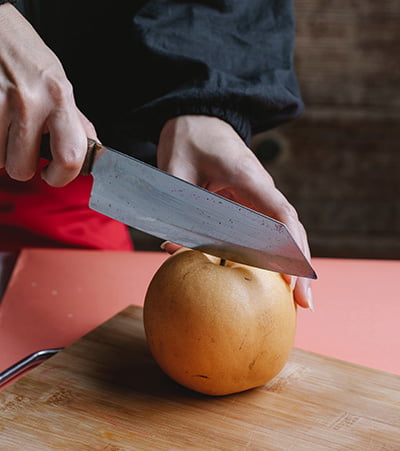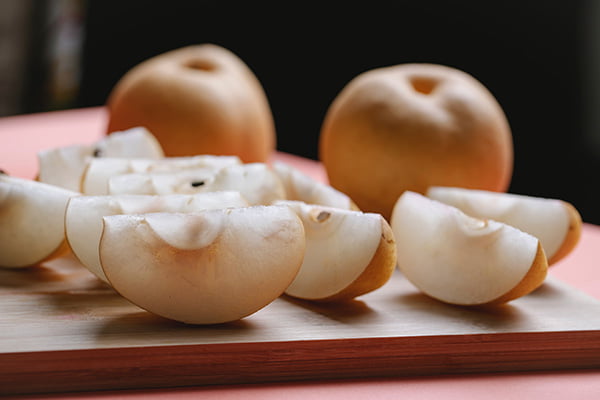Introducing the Asian pear - a fruit that's taking the culinary world by storm with its unbeatable combination of sweetness, crunch, and refreshment. With a history dating back thousands of years, this exotic and special fruit has been enjoyed by Asian cultures for its juicy, fragrant flesh and subtle, floral undertones. But now, the secret's out, and the Asian pear is quickly becoming a favorite among foodies and health enthusiasts alike. From snacking on a crisp slice to incorporating it into salads, desserts, and cocktails, the Asian pear is a versatile and delicious addition to any kitchen.
Whether you are new to Asian pear or learning different ways to enjoy this delicious fruit, below you will learn all about this amazing fruit.
What Is An Asian Pear?
Pyrus pyrifolia is the majestic pear tree that yields the juicy and crispy Asian pear - a fruit that has captured the attention of food enthusiasts around the world. Also known as the "nashi apple," "apple pear," "Japanese pear," "sand pear," "bapple," "zodiac pear," "Korean pear," "Korean Giant," or "bae," this fruit is primarily grown in East Asia. But its popularity has now spread to other parts of the world.
Today, you can find Asian pear trees in the United States, primarily concentrated in California. Asian pears are also grown in smaller quantities in other parts of the US, including Washington, Oregon, and Georgia. These pears are typically grown in orchards and harvested in the late summer and early fall. And unlike European pears and other types of pears, Asian pears ripen on the tree and maintain their texture and taste long after being picked.
What Does Asian Pear Taste Like?
When it comes to flavor, the Asian pear is truly a one-of-a-kind fruit. With its grainy texture and juicy flesh, biting into an Asian pear is like experiencing a refreshing explosion of flavor in your mouth. Its taste is subtly sweet, with hints of honey and vanilla and a delicate floral aroma that's almost reminiscent of a tropical paradise.
Unlike traditional western pears, Korean pears have a crunchy texture that's more akin to biting into an apple, making them a refreshing treat for any time of day. Whether enjoyed independently or as part of a creative recipe, the Asian pear's unique taste will leave a lasting impression.

Asian Pears Varieties
There are several varieties of Asian pears, each with its own unique characteristics in terms of flavor, texture, and appearance. Some of the most common Asian pear varieties include:
Hosui: This variety is a popular choice among Asian pears, with yellow-brown skin and a juicy, sweet flavor.
Chojuro: Known for its round shape and green-yellow skin, this variety has a crisp texture and slightly tart flavor.
Shinko: With brownish-green skin and a juicy, refreshing taste, Shinko is a favorite among Asian pear enthusiasts.
20th Century: This variety has a distinctive shape and yellow-green skin, with a crispy texture and mild, sweet flavor.
Niitaka: This large, round pear has yellow-green skin and a crisp texture with a slightly tart flavor.
Shinseiki: This variety has a light green skin and juicy, sweet flavor, making it a popular choice for eating fresh.
Ya Li: Also known as "Duck pear," this variety has a yellow-brown skin and sweet, juicy flesh that's perfect for eating fresh or using in cooking.
Health Benefits
Rich in fiber
This amazing fruit is packed with fiber, which is essential for maintaining healthy digestion and promoting regular bowel movements.
Loaded with vitamins and minerals
This delicious and juicy fruit is loaded with essential nutrients, including vitamins C, K, and potassium. Vitamin C is a powerful antioxidant that supports the immune system and promotes healthy skin and tissue repair. Vitamin K is important for healthy bone development and maintenance, while potassium helps to regulate blood pressure and support healthy muscle and nerve function.
Supports immune function
Thanks to its high vitamin C content, the Asian pear can help support healthy immune function and protect against illness.
Promotes heart health
With its low fat and low-calorie content, the Asian pear makes a great choice for anyone looking to support heart health and maintain a healthy weight.
Supports bone health
Asian pears are a good source of vitamin K, which is essential for healthy bone development and maintenance.
May help regulate blood sugar
Because of the high dietary fiber content, Asian pears may help regulate blood sugar levels, making them a smart choice for anyone looking to manage their blood sugar.
Contains antioxidants
The Asian pear is rich in antioxidants, which can help protect against free radical damage and support overall health and well-being.
Promote Weight Loss
The high fiber content in Asian pear can help keep you feeling full and satisfied for longer, making the Asian pear a great choice for anyone trying to maintain a healthy weight. With its sweet and juicy flavor, the Asian pear is the perfect snack to help keep you feeling energized and satisfied throughout the day.
A Good Source Of Folate
These juicy, sweet fruits are packed with flavor and folate, making them a fantastic choice for anyone looking to support a healthy pregnancy or boost their overall wellness.
Asian pears are an excellent source of folate, with just one medium-sized fruit containing up to 10% of your daily recommended intake. Adding Asian pears to your diet is an easy and tasty way to ensure you get the folate your body needs to thrive.

How to eat Asian pear
You can eat Asian pears like most other pears. Here are some ideas:
Slice it up
Wash the pear and slice it into thin wedges or bite-sized pieces. Enjoy it as a healthy and refreshing snack on its own, or pair it with your favorite cheese or nut butter.
Add it to salads
Sliced Asian pears make a delicious and unique addition to salads. For a delicious and healthy meal, try tossing them with mixed greens, nuts, and a simple vinaigrette.
Use it in smoothies
Asian pears add natural sweetness and a refreshing flavor to smoothies. Blend sliced pears with your favorite fruits and veggies, and enjoy a nutritious and delicious drink.
Make a dessert
Asian pears can be used in various desserts, from tarts to crumbles to pies. Slice them thinly, layer them on a baked pastry or crust, and enjoy a sweet and satisfying treat.
In Asian culture, you can often find Asian pears in snow fungus soup and dessert soup.
Juice it
If you have a juicer, you can easily turn Asian pears into a refreshing and nutritious juice. Simply wash and core the fruit, and run it through your juicer for a delicious and healthy drink.
Because Asian pear is sweet, it goes well with any greens and brings sweetness to those mean green juice recipes.
Chinese Pear Soup
In Asian culture, Asian pear soup is a popular drink during cold and flu season. This unique and delicious beverage is a warm, comforting treat perfect for cooler weather.
To make hot Asian pear juice, wash and slice the pears into small pieces. Add them to a pot with water, cinnamon sticks, and other spices like cloves or ginger. Bring the mixture to a boil and then reduce the heat and let it simmer for 20-30 minutes until the pears are soft and the spices have infused the liquid. Adding some honey when serving can help calm a cough and soothe the throat.
Add into marinades
Adding Asian pear to a marinade is a great way to add a unique flavor and texture to your dishes. The natural sweetness and tender texture of Asian pear make it an ideal ingredient for marinades that are used to flavor meats like short ribs, poultry, or even vegetables.
To make a marinade, start by peeling and grating the pear, and you can also chop it into small pieces if you prefer. Then, mix the grated or chopped pear with other ingredients, such as soy sauce, garlic, ginger, and sesame oil, to create a flavorful marinade.
How To Choose Asian Pears
When it comes to selecting the perfect Asian pear, there are a few key things to keep in mind.
First, look for pears that are firm and free of any bruises or soft spots. The skin should be smooth and shiny, with a light golden or yellow hue. Avoid pears with any discoloration or brown spots, as this could be a sign of decay.
Pay attention to the shape of the pear. Asian pears are typically round or oval in shape, with a slightly flattened bottom. Choose pears that are symmetrical and have a consistent shape, as this can be an indicator of ripeness.
Give the pear a gentle squeeze at the stem end. It should give slightly, but not be too soft. If the pear is too soft or mushy, it may be overripe and less enjoyable to eat.
Take a whiff of the pear. It should have a subtle, sweet aroma that is slightly floral. The pear may be past its prime if it has a strong, pungent odor.
How to Store Asian Pears
Unlike some other fruits, Asian pears should not be stored in the refrigerator. Instead, they should be stored at room temperature, ideally in a cool and dry place away from direct sunlight.
Asian pears should be stored separately from other fruits, as they release a natural gas called ethylene that can cause other fruits to ripen and spoil more quickly. And if you want to speed up the ripening process of your Asian pears, you can place them in a paper bag. This will help trap the ethylene gas and accelerate the ripening process. Once they are ripe, remove them from the bag and store them at room temperature.
